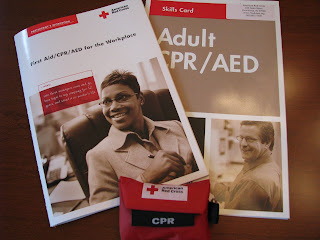If you witnessed someone having a heart attack, would you know what to do?
 I'm now better prepared to respond should I find myself in such unfortunate circumstances. Last week I became certified in CPR and the use of an automated external defibrillator (AED) by taking a 3-hour class at the Rhode Island Red Cross headquarters in Providence.
I'm now better prepared to respond should I find myself in such unfortunate circumstances. Last week I became certified in CPR and the use of an automated external defibrillator (AED) by taking a 3-hour class at the Rhode Island Red Cross headquarters in Providence.Why did I do it? The short answer is that I had to, because I need that little certification card before I can even take the American Council on Exercise personal trainer exam.
 But after having taken the class, I'd like to think that even if things don't work out for me as a personal trainer, I will maintain my CPR/AED certification. The class was completely painless — no embarrassing moments pretending to be a victim while the rest of the class watches — and easily worth a few hours of my time and $45.
But after having taken the class, I'd like to think that even if things don't work out for me as a personal trainer, I will maintain my CPR/AED certification. The class was completely painless — no embarrassing moments pretending to be a victim while the rest of the class watches — and easily worth a few hours of my time and $45.There were about a dozen of us in the class, and we paired off to practice such skills as aiding a choking victim, but had our own mannequins on which to practice the rescue breaths and chest compressions of CPR. We went through the CPR steps as a group, following along with an instructional video, and the instructor made the rounds to make sure each of us was doing it correctly.
I was impressed that a few people had attended the class not because certification was a job requirement, but because they wanted to be prepared in an emergency. One young's man story was particularly touching: He said his grandfather had started choking on some food a few weeks before, and he wished he had known how to help.
The instructor, Keith Choquette, who said he spent 10 years as an emergency medical technician before becoming an instructor with the Red Cross, was very candid about the chances of reviving someone with CPR alone: about 5 percent. CPR in combination with the use of an AED brings those chances up to 10 percent, he said.
But he made a point that had never occurred to me, which was that even if the heart attack victim does not survive, CPR can greatly improve the odds that the victim's organs can still be donated. So a bystander who performs CPR might not be saving the heart attack victim's life, but could be saving the lives of many others.
And though those odds of survival are terribly slim, think about how they would sound if you or someone you loved were the victim. As Choquette said, "A chance is a chance."
To find a CPR course near you, contact the American Red Cross.


No comments:
Post a Comment